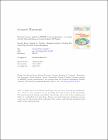| dc.contributor.author | CROWLEY, QUENTIN | en |
| dc.date.accessioned | 2012-06-27T15:49:30Z | |
| dc.date.available | 2012-06-27T15:49:30Z | |
| dc.date.issued | 2012 | en |
| dc.date.submitted | 2012 | en |
| dc.identifier.citation | Ryszard Kryza, Quentin G. Crowley, Alexander Larionov, Christian Pin, Teresa Oberc-Dziedzic, Ksenia Mochnacka, Chemical abrasion applied to SHRIMP zircon geochronology: An example from the Variscan Karkonosze Granite (Sudetes, SW Poland), Gondwana Research, 21, 2012, 757-767 | en |
| dc.identifier.other | Y | en |
| dc.identifier.uri | http://hdl.handle.net/2262/64063 | |
| dc.description | PUBLISHED | en |
| dc.description.abstract | Thermal annealing followed by acid etching of zircon (chemical abrasion or CA) can be successfully utilised to minimize or eliminate the effects of major and cryptic Pb-loss for SIMS U?Pb zircon dating. The procedure is demonstrated by applying the U?Pb SIMS technique to both untreated and chemically abraded zircons from the Karkonosze Granite, Sudetes, SW Poland. Conventional U?Pb SIMS dating of untreated zircons yields an apparently coherent age population (n = 9) with a weighted mean 206Pb/238U age of 306 ? 4 Ma. Some untreated zircons display anomalously young 206Pb/238U ages (c. 225 and 238 Ma) and are likely to have suffered substantial Pb-loss. A sub-set of zircons from the same sample was chemically abraded. Physically, zircons treated in this manner display a range in the degree of etching and partial dissolution. Extreme examples developed a 3D network of sub-?m channels which follow high-U (dark CL) zones or linear defects, such as micro fractures or indistinct cleavage planes. U?Pb SIMS dating of treated zircons (n = 11) yields a mean 206Pb/238U age of 322 ? 3 Ma. Two analyses of treated zircons still display younger 206Pb/238U ages (c. 297 and 301 Ma) ascribed to the effects of Pb-loss.
For the analysed sample, U?Pb ages determined from chemically abraded zircons are c. 5 % older than those from untreated zircons. This is attributed to effective removal of metamict domains susceptible to Pb-loss. The CA technique also removes micro-inclusions thus lowering common Pb and reducing matrix effects. A cryptic Pb-loss in untreated zircons is only recognised when compared with chemically abraded counterparts or ages determined using other isotope techniques. This clearly demonstrates the utility of CA to high-spatial resolution methods and stresses that Pb-loss is detectable at a range of scales, regardless of the analytical technique used. | en |
| dc.description.sponsorship | This research was carried out under the Project MNiI 5T12B 036 25 of the Polish National Research Committee (KBN). Additional support came from internal grants 1017/S/ING and 2022/W/ING of the University of Wroclaw. Thanks to Anna Pietranik and the University of Bristol Lab team for performing laser ablation ICP-MS analyses of Hf and REE in zircons, and to Grenville Turner (BGS) for providing SEM zircon images | en |
| dc.format.extent | 757-767 | en |
| dc.language.iso | en | en |
| dc.relation.ispartofseries | Gondwana Research | en |
| dc.relation.ispartofseries | 21 | en |
| dc.rights | Y | en |
| dc.subject | Geology | en |
| dc.subject | Zircon | en |
| dc.subject | SHRIMP geochronology | en |
| dc.subject | Chemical abrasion | en |
| dc.subject | Radiogenic lead loss | en |
| dc.subject | Karkonosze Granite | en |
| dc.title | Chemical abrasion applied to SHRIMP zircon geochronology: An example from the Variscan Karkonosze Granite (Sudetes, SW Poland) | en |
| dc.type | Journal Article | en |
| dc.type.supercollection | scholarly_publications | en |
| dc.type.supercollection | refereed_publications | en |
| dc.identifier.peoplefinderurl | http://people.tcd.ie/crowleyq | en |
| dc.identifier.rssinternalid | 74466 | en |
| dc.subject.TCDTheme | Smart & Sustainable Planet | en |
| dc.identifier.rssuri | http://dx.doi.org/10.1016/j.gr.2011.07.007 | en |
| dc.identifier.orcid_id | 0000-0001-9254-6657 | en |




